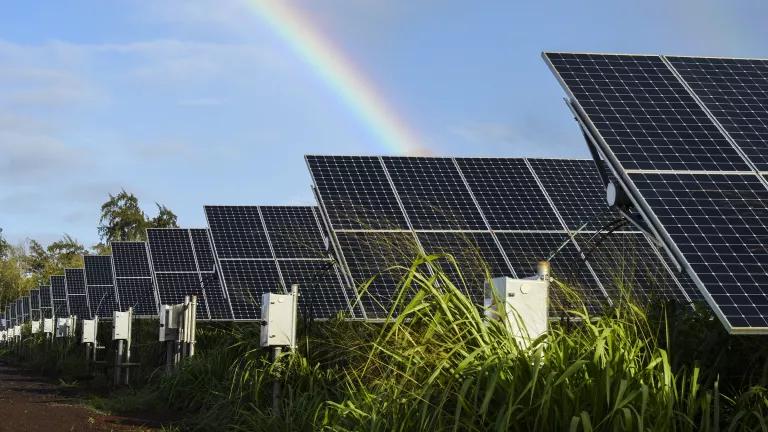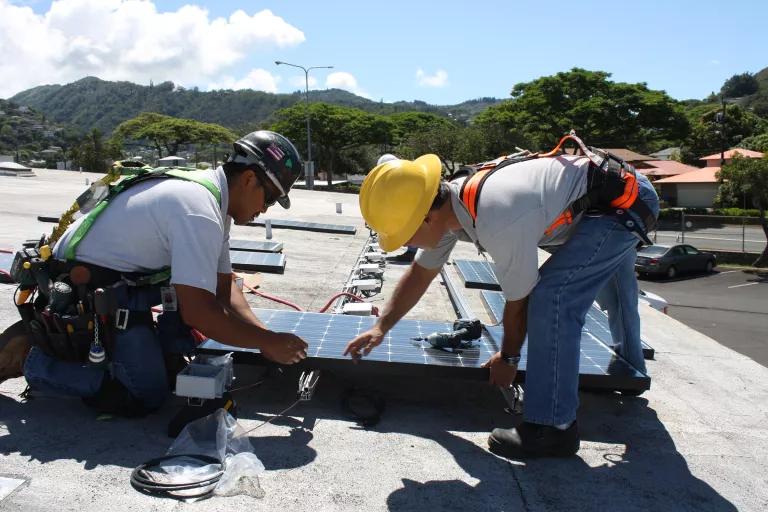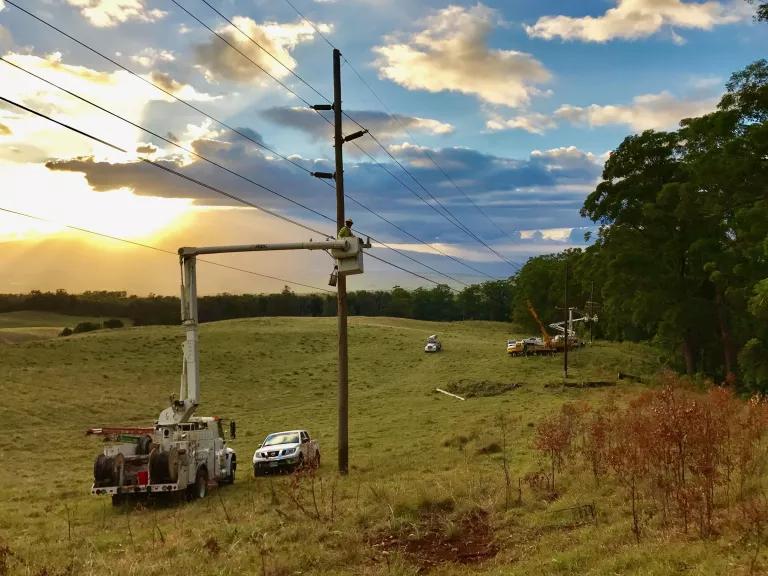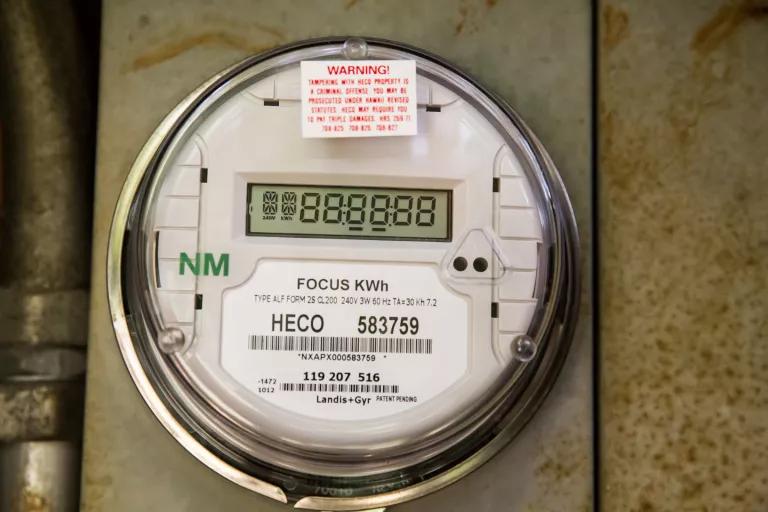Will Hawai‘i Show the Rest of the Nation the Way to Clean Up the Power Sector?
To help achieve 100 percent renewable energy by 2045, the state’s electric utilities now need to take up climate action if they want to turn a profit.

A solar panel array at the AES Lawai Solar Project in Kauai, Hawai'i
From his home in the Hawai‘i Kai neighborhood of O‘ahu, Joe Viola watched the news coming out of Texas earlier this year in shock. In February, the Texas power grid collapsed under the weight of a winter freeze and wiped out electricity for 70 percent of the state’s utility customers.
As a vice president at Hawaiian Electric Company, Viola could very easily imagine the questions facing his Texas peers in the wake of the disaster. Nearly 15 million people had been cut off from access to safe drinking water. At least 300 died. And the president of the state’s primary grid operator said the system was just “seconds and minutes” away from the kind of complete blackout that could have taken months to restore.
Viola also knew that the crisis was avoidable. All of this came after freezes in 1989, 2003, 2011, and 2014—as well as a 2011 report from the Federal Energy Regulatory Commission that warned Texas it was time to winterize its infrastructure and improve grid resilience. Yet local utilities had focused only on the price tag and shrugged off the advice.
Of course, Hawai‘i doesn’t need to winterize. But it does need to prepare for extreme storms and wild temperature swings, which could likewise wreak havoc on its grid. And so, with a determination not to follow Texas’s mistakes or the underlying climate denialism that fueled them, Viola and others are seeking to forge a new, healthier relationship between utilities and their customers.
As a step in that direction, in June, the state implemented a new regulatory framework for utilities meant to hold them accountable to Hawai‘i’s goal of reaching 100 percent renewable energy by 2045. Called performance-based regulation (PBR), the system breaks from the tradition whereby utility companies—which are regulated by state governments but typically set the rates they charge customers—can make more money simply by selling more energy. The regulatory commission now caps revenue from customer usage, and utilities looking to make more money will need to improve the service they provide through means such as energy efficiency upgrades.
“If Texas had had a PBR, that [collapse] never would have happened,” Viola says.
Tackling the Climate Crisis and Housing Affordability at Once
Hawai‘i’s new utility framework follows Honolulu’s recent adoption of an energy code that aims to boost efficiency in buildings and accommodate the growing demand for rooftop solar and electric vehicles. The state’s utility companies will receive financial rewards for achievements like speeding up work to connect rooftop solar panels to the grid or transforming the grid to better distribute the energy that rooftop solar customers are generating. There will also be incentives for further electrifying transportation throughout the state. The financing behind each reward is built into future rates, which means customers would only pay more if they get more service.

“These are discrete outcomes that we’re motivating the utility to achieve,” says Jay Griffin, who, as chairman of the Hawaiʻi Public Utilities Commission (PUC), worked closely with Viola and other stakeholders.
Some of the rewards that the PUC in Hawaiʻi is offering seek to improve service more immediately for low-income communities, particularly with access to efficiency programs. In Texas, the power crisis was exacerbated by a plethora of energy-inefficient buildings with poor insulation and drafty windows, which drove unsustainable demand for heating during a very cold week. Of course, Texan heat waves also stress the grid, as they do in Hawaiʻi, when residents rely more heavily on AC, and in turn, see their power bills skyrocket.
“Energy efficiency is a pretty critical tool for creating bill affordability,” says Rachel Gold, director of the utilities program at the American Council for an Energy-Efficient Economy. Indeed, high costs of electricity are a factor in Hawaiʻi’s sky-high cost of living, due to the financial impacts of shipping in petroleum from thousands of miles across the Pacific Ocean. Hawai‘i residents pay upwards of 20 percent more than the national average for gasoline, and more than double for electricity. Initiatives to upgrade homes to be more energy efficient would help lower demand for power overall, reducing what residents have to pay, even when emergency strikes.
One provision that stands out to Gold is the incentive for utilities to install high-tech meters that allow them to capture vastly more detailed data on energy consumption, which can help shape guidance for customers. “You can say things like your bill is tracking ahead of where it was last year. Or you can say, you can really help the grid out if you reduce your usage at this specific time. Also targeting customers for specific programs becomes more possible when you have access to that granular data.”
Lilia Tollefsen, who taught public school for 15 years and now manages a horse and cattle ranch on the Windward side of Oahu, knows firsthand how prohibitive the cost of living can be in Hawai‘i. All three of her sisters have left the state because they could not keep up with the costs ofnnecessities like food and utilities.
Tollefsen says that if she didn’t share a home with her parents, she, too, would have to leave the island where her family has lived for generations. She was able to install solar panels years ago, realizing longer-term savings, and she’s happy to see other members of her community get greater access to more efficiency and better rates. “People here want to do good for the earth,” she says, “but at the end of the day, it comes down to their bottom economic line. For me and my circle of people, we want to do good, and if it can come at a price we can afford, we’ll pick that option. But if it comes at a price that I can’t afford, it’s not even an option. This provides an awesome way to help people make change.”
The authors of the PBR framework put mechanisms in place to ensure that the utilities would follow through on the various cost-savings recommendations they outlined, such as cutting their numbers of executive positions. One is a requirement that they set aside $33 million in “customer dividends.” These dividends are the customers’ share of the savings that officials expect will be realized once the utilities implement the various changes; $33 million will be paid out to customers over the next five years in the form of lowered rates. The first reduced bills went out in June.
“For most middle-income and low-income families, the cost of living in Hawai‘i is just crazy,” says Tollefsen. “So any place where we can, as a state, be wiser with our money and cleaner with our money and pass those savings on to the people who live here is greatly appreciated. People can put those savings toward other necessities.”

A Model of Grid Resilience Planning for the Nation
Hawaiʻi’s PBR, set to last five years, is the result of painstaking negotiations between the utilities, wind and solar power companies, county and municipal officials, and local environmental advocacy groups, including the Blue Planet Foundation. “Better aligning the utilities’ profits with customer interests and the state’s clean energy goals is a necessary step in our transition to 100 percent clean energy,” says Melissa Miyashiro, managing director of strategy and policy at Blue Planet Foundation. “It’s been a long road. Blue Planet has been advocating for reforms of utility incentives for more than a decade, through this and earlier legal proceedings and through legislation in 2018 that jump-started the current PBR framework.”
While other states have experimented with “decoupling” revenue from energy consumption, or putting in place some of the individual PBR provisions, Hawaiʻi is the first state to attempt a complete philosophical and practical overhaul. “It’s very ambitious in its comprehensiveness,” says Gold. “It moves past a business model that rewards utilities for increasing costs and realigns their fundamental incentives.”
Griffin anticipates that the financial incentives will encourage the utilities to be proactive in reaching for the 2045 all-renewable-energy goal. “We’ve made the economics very compelling,” he says, “so we hope to see utilities much more aggressively focused on renewables.” These state efforts will also be supported through tandem federal initiatives under President Biden’s Build Back Better agenda, which will invest in more resilient electricity transmission, among other goals to clean up the power sector.

Hawai‘i’s new framework doesn’t take a smooth implementation for granted; it includes plans to come back to the table to work out any unintended kinks. “If this were easy,” Viola says, “everyone would have done it already. We know it’s not going to be perfect—and we put in provisions for that.”
Regardless of how the rollout goes, Griffin notes that retreat is not an option. “We’re not going back. We put language in to encourage longer-term organizational changes to improve efficiency and achieve clean energy goals,” he says, adding that the hope is to ignite more entrepreneurial thinking among stakeholders.
With the stakes of climate inaction too steep to continue with business as usual—as was made clear in the most recent report from the Intergovernmental Panel on Climate Change—energy leaders outside the Aloha State are eager to learn whether Hawai‘i’s approach is widely replicable. Many are already studying the plan’s fine print and making calls to Griffin, who says he’s heard from regulatory colleagues in Colorado, Michigan, Nevada, Oregon, Washington, and Wisconsin. “I know there are a lot of eyes watching.”
This NRDC.org story is available for online republication by news media outlets or nonprofits under these conditions: The writer(s) must be credited with a byline; you must note prominently that the story was originally published by NRDC.org and link to the original; the story cannot be edited (beyond simple things such as grammar); you can’t resell the story in any form or grant republishing rights to other outlets; you can’t republish our material wholesale or automatically—you need to select stories individually; you can’t republish the photos or graphics on our site without specific permission; you should drop us a note to let us know when you’ve used one of our stories.

Wind Energy
What’s the Most Energy-Efficient Water Heater?
How to Ditch the Biggest Fossil Fuel Offenders in Your Life